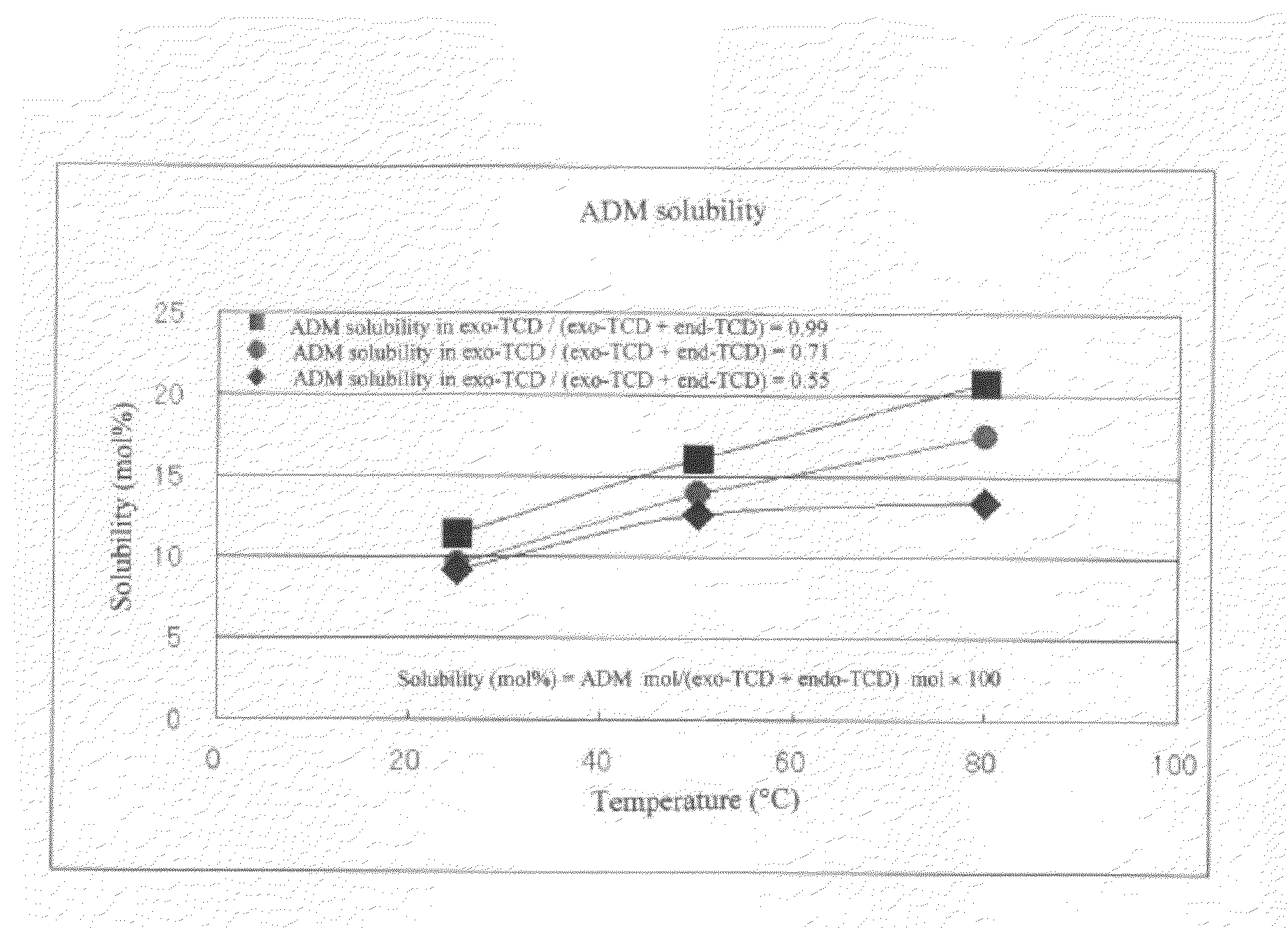Process for producing adamantane
a technology of adamantane and adamantane, which is applied in the field of continuous production of adamantane, can solve the problems of unavoidable use of solvents, conventional techniques of using hf catalysts and bf/sub>catalysts,
- Summary
- Abstract
- Description
- Claims
- Application Information
AI Technical Summary
Benefits of technology
Problems solved by technology
Method used
Image
Examples
example 1
[0055]An isomerization reaction of TCD was performed using a continuous two-stage reactor including two hastelloy autoclaves connected to each other. Each autoclave has an internal volume of 0.5 L and includes an electromagnetic stirrer, a heater, a gas and liquid supply opening, and a reaction product discharge opening. Into the first-stage reactor, 300 g of HF catalyst (reagent: produced by Morita Chemical Industries, Co., Ltd.) was put, and into the second-stage reactor, 300 g of HF catalyst was put. The first-stage reactor was heated to 30° C. and the second-stage reactor was heated to 50° C. by the heater. Then, to the first-stage reactor, the following substances were supplied separately: TCD having an exo / endo isomer ratio of 0.285 and a purity of 99.2% (prepared by the company of the present inventors) at a ratio of 2.80 g / min., the HF catalyst at a ratio of 2.06 g / min., and a BF3 catalyst (reagent: produced by Stella Chemifa Corporation) at a ratio of 0.14 g / min. The amount...
example 2
[0057]The same procedure as in Example 1 was performed except that TCD which was endo-TCD having a purity of 99.5% was used as a starting material. The composition of the reaction-produced solution in the first-stage reactor was exo-TCD: 87 mol %; adamantane: 9 mol %; and endo-TCD: 0.8 mol %. With respect to 1 part by weight of TCD as the starting material, the ratio of exo-TCD was 0.99 parts by weight (87 / (87+0.8)=0.99) and the ratio of endo-TCD was 0.009 parts by weight (0.8 / (87+0.8)=0.009). The composition of the reaction-produced solution in the second-stage reactor was exo-TCD: 75 mol %; adamantane: 15.2 mol %; and endo-TCD: 0.5 mol %. With respect to 1 part by weight of TCD as the starting material, the ratio of exo-TCD was 0.99 parts by weight (75 / (75+0.5)=0.99) and the ratio of endo-TCD was 0.007 parts by weight (0.5 / (75+0.5)=0.007). Based on the composition of the reaction-produced solution after the two-stage continuous isomerization reaction, the TCD conversion was 100−(7...
example 3
[0058]The same procedure as in Example 1 was performed except that TCD which was exo-TCD having a purity of 99.4% was used as a starting material. The composition of the reaction-produced solution in the first-stage reactor was exo-TCD: 86 mol %; and adamantane: 10 mol %. With respect to 1 part by weight of TCD as the starting material, the ratio of exo-TCD was 1.00 parts by weight (86 / (86+0)=1.00). The composition of the reaction-produced solution in the second-stage reactor was exo-TCD: 75 mol %; and adamantane: 15.6 mol %. Based on the composition of the reaction-produced solution after the two-stage continuous isomerization reaction, the TCD conversion was 100−75=25 mol %, the yield of adamantane was 15.2 mol %, and the selectivity of adamantane was 15.2 / 25×100=60.8 mol %.
PUM
| Property | Measurement | Unit |
|---|---|---|
| melting point | aaaaa | aaaaa |
| temperature | aaaaa | aaaaa |
| melting point | aaaaa | aaaaa |
Abstract
Description
Claims
Application Information
 Login to View More
Login to View More - R&D
- Intellectual Property
- Life Sciences
- Materials
- Tech Scout
- Unparalleled Data Quality
- Higher Quality Content
- 60% Fewer Hallucinations
Browse by: Latest US Patents, China's latest patents, Technical Efficacy Thesaurus, Application Domain, Technology Topic, Popular Technical Reports.
© 2025 PatSnap. All rights reserved.Legal|Privacy policy|Modern Slavery Act Transparency Statement|Sitemap|About US| Contact US: help@patsnap.com



